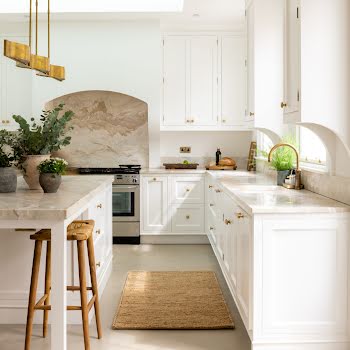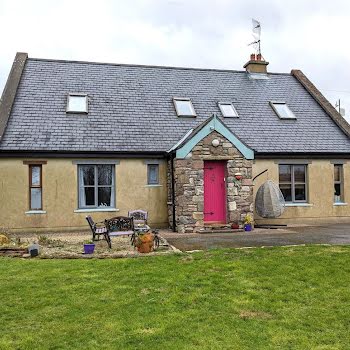
By IMAGE Interiors & Living
06th Aug 2020
06th Aug 2020
It’s no secret that this ubiquitous material can be used in innovative ways to create comfortable concrete interiors, says Gearóid Carvill of architecture and design practice abgc.
You’re never too far away from concrete. It forms walls, floors and pavements up and down the country. As a building material, concrete has been widely used in domestic construction since Victorian times, and particularly in cities where many a brick fronted building conceals an in situ cast structure.
Little has changed in terms of the basic ingredients of sand, cement and aggregate since the Portland cement of the 19th century. What has changed is the awareness that this material can have variety and style, how it can be used to create furniture and accessories, and be used as a finish itself, through subtle variations in its ingredients. There are even opportunities to turn historically concealed elements of buildings into stunning design features in themselves.
INDOORS
FLOORING We’re seeing a lot more exposed concrete floors than ever before. There is a clean, cool, modern aesthetic to the smooth finish extending across a room, giving the texture and shine of a stone floor, but without all of the busy joint lines.

The crisp white concrete of Dublin shop Nowhere was created by abgc.
A terrazzo effect can be achieved by grinding a few millimetres off the top and exposing the stone within – here subtle changes in the colour of cements and sizes of aggregates mean that a fantastic array of blends and finishes can be created. With all of these variations, the key is to agree on samples. We achieved a white concrete effect in the Dublin clothing store Nowhere by using white sand, white cement and white marble aggregate. Dyes can also be added to create different colours.
Apart from these aesthetic qualities, concrete gives a low-dust, low-VOC (volatile organic compounds that can be damaging to health), easily cleaned surface that enhances daylight and is underfloor heating compliant. You may already have an existing concrete floor slab under your floorboards, which is a fantastic sustainable option. However, expert advice will be needed, as any required repairs to the slab may be visible in the finished floor after grinding.
FURNITURE For the completist, almost everything (bar the living room sofa) can be cast in concrete. The architectural studio Assemble’s Granby Four Streets project involved recycling construction waste as aggregate in polished concrete furniture, a component of a project that ultimately won them the Turner Prize in 2015.
Anywhere stone might be used, concrete can also be used; think kitchen counters, tabletops and vanity units. The advantage of concrete is that because it is cast, it can create a seamless face to a piece of furniture, as well as its top.
 Tactility Factory’s linen-infused concrete
Tactility Factory’s linen-infused concrete
FITTINGS Somewhere between art and science are Belfast-based Tactility Factory‘s velvet, bead and linen infused concrete panels. Each one is a work of art. The linen-infused panels reference an industrial heritage, and each take pieces of traditional craft and radically transform them. The panels work to a standard size, but they accept large bespoke commissions. Light things and pendants are also available and not at extraordinary prices.
. 
Ail + El’s concrete-inspired homewares.
ACCESSORIES: There’s plenty of indigenous talent out there. Ail+El’s range of homeware balance natural textures with strong graphic sensibility, while Hey Bulldog Design‘s are equally fun take on the building material. Or if you fancy a bit of Irish hygge in your home, check out Danish-born, Cork-based Kevin Corcoran’s Concrete Forest candle holders.

Blobs clock, €50, Hey Bulldog Design
OUTDOORS
Concrete is of course suitable for use externally, and is an ideal alternative to replace rotting sleeper raised beds and crazy-paved patios. As it can be cast into almost any form, it can be used to create walls, planters and changes of level, as well as surfaces. Different polishing, sandblasting and washing methods mean there are options for the texture and tactility, but good craftsmanship is key.
Combinations of texture and colour can help define areas and routes, though we find that the best results are where the concrete is counterpointed with other natural materials, be it hardwood, brick or soft-edged planting.
You can add great visual interest to your garden by lightly washing the concrete after a mild cure to create an in-situ cast slab or raised bed. Using an exposed aggregate texture not only hides dirt, but also gives grip underfoot on rainy days. Using rounded river pebble as the aggregate eliminates sharp corners, and the same pebble can be used as a border to provide drainage and harmonise the colour balance in the hard landscaping.

A mix of smooth concrete, aggregate and rounded pebble will add a variety of texture to your garden, as in this abgc project.
PLANNING A CONCRETE PROJECT?
Some tips if you’re planning on introducing concrete into your home or project.
- Get early cost and timing advice.
- Request a sample. With so much variation in finish possible, it is crucial to request and agree on a sample where the colour, level of grind and type of aggregate have been tweaked.
- Do request to view a built example, not just photos.
- Ask about the amount of potential variation in the finished installation.
- Expect some change. Concrete takes months to dry and colour will lighten subtly over time.
- Do expect some designed joints as part of the design. These are almost always necessary in any large or complex plan.
- Do get advice on correct maintenance, particularly for highly polished floors and counters. Concrete does not like the acids found in some household cleaners.
- Don’t do it yourself unless cracks are your thing and personal safety is not.
- Don’t risk ‘saving’ by having an inexperienced contractor attempt to execute part of the works for you.
Photo by Taylor Simpson on Unsplash
Read more: This vintage-filled Belfast apartment was once part of a military hospital
Read more: This surprisingly roomy four-bed house in Dalkey is on the market for €2,000,000
Read more: Colourful splashbacks to convince you to go bright in your kitchen























